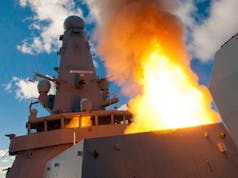The Ministry of Defence has issued a new tender for Atlantic Net, the opening phase of Project CABOT, which aims to advance the Royal Navy’s use of uncrewed and data-driven systems for anti-submarine warfare and maritime intelligence.
According to the tender, “the Ministry of Defence would like to announce the intention to publish an Invitation to Tender (ITT) to contract a Commercial Mission Partner(s) (CMP) as part of the Royal Navy’s Atlantic Net (AN) initiative in the near future.”
The MOD says Atlantic Net “will deliver Underwater Intelligence, Surveillance & Reconnaissance (ISR) as a service through a Contractor Owned, Contractor Operated, Naval Oversight (COCONO) model.”
The system, it continues, “will be data focussed, providing information direct to the Maritime Operational Commander ashore to inform decision making.” The framework, valued symbolically at £1 for each of its two lots, will operate between 17 December 2025 and 31 March 2026, according to the entry on the Find a Tender portal.
The first lot will appoint Commercial Mission Partners, each of whom will be awarded an individual call-off contract “detailing the milestones, deliverables and commercial terms that are specific and relevant to them.”
The second will establish a Potential Supplier Pool for additional firms whose technologies or services “may be of interest to the Authority and, consequently, may be contracted for through a Call-Off Contract at any point during the Term of the Open Framework.”
The notice also specifies that the procurement is “exempt from the Procurement Act 2023 under Defence Intelligence and National Security Grounds.” However, the MOD added that it intends to “follow the spirit of the Procurement Act where possible, hence the open publication of this notice.”
Atlantic Net represents the first phase of Project CABOT, which the MOD has described as designed to “accelerate the RN’s pivot to autonomy with a specific focus on Anti-Submarine Warfare.” It builds on prior innovation efforts under Project CHARYBDIS and the Defence Innovation Unit’s ASW Spearhead programme, and aligns with NATO’s wider Smart Defence initiative to create an automated anti-submarine warfare barrier using digital, networked systems.
Future phases, including Atlantic Bastion, are expected to bring those capabilities under direct Royal Navy control, employing government-owned Type 92 Sloop drone ships and Type 93 Chariot autonomous submarines.
The two phases aim to reduce reliance on crewed platforms and create a persistent undersea surveillance network capable of tracking submarine activity across the North Atlantic.













Will be interesting to see what tech is proposed under Lot 2.
Seems to be less of a focus on T92 and T93 as large platforms in this notice. Do the MoD expect there to be a less centralised approach to the initial Atlantic Net, maybe using lots of small UUVs as a sonar array rather than a SURTASS type towed array platform?
We currently use quite a few fixed sonar buoys in the GIUL gap, witches nice to detect something that goes through but if we can’t get there quickly enough it will have passed out of the range of the buoys before our ships can tag along.
Swapping to small drones that could follow a bit until the Type 26 arrives, or move to investigate something odd would be pretty helpful.
And thankfully nothing this size should be too expensive. It should be the price of whatever the boys are, plus a small engines, and as the programming isn’t a highly complex one compared to what some drones might need to do that software shouldn’t be too expensive either.
Contractor Owned, Contractor Operated, Naval Oversight (COCONO)….
So gone are the days a military system is operated by military people.
So in time of war, if this system detects bad guy – who gives the fire order? The tea boy apprentice on a government training scheme?